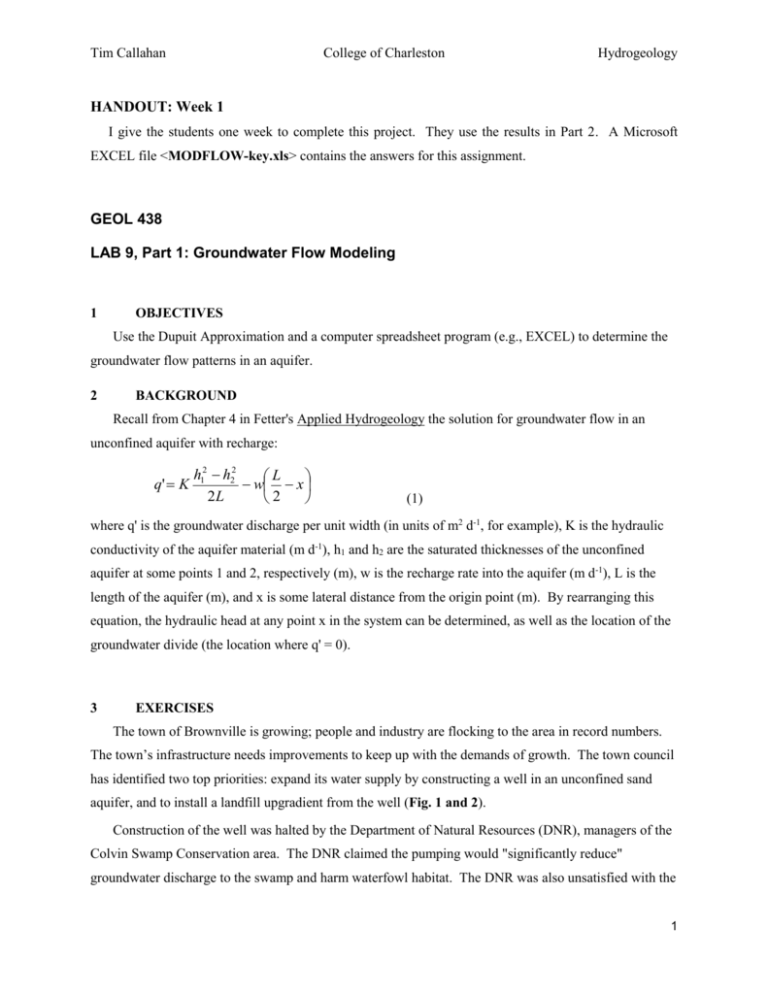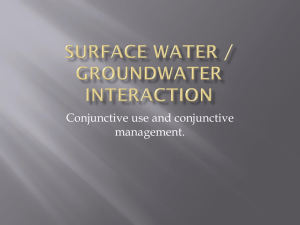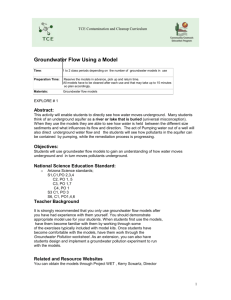Callahan-MODFLOW
advertisement

Tim Callahan College of Charleston Hydrogeology HANDOUT: Week 1 I give the students one week to complete this project. They use the results in Part 2. A Microsoft EXCEL file <MODFLOW-key.xls> contains the answers for this assignment. GEOL 438 LAB 9, Part 1: Groundwater Flow Modeling 1 OBJECTIVES Use the Dupuit Approximation and a computer spreadsheet program (e.g., EXCEL) to determine the groundwater flow patterns in an aquifer. 2 BACKGROUND Recall from Chapter 4 in Fetter's Applied Hydrogeology the solution for groundwater flow in an unconfined aquifer with recharge: q' K h12 h22 L w x 2L 2 (1) where q' is the groundwater discharge per unit width (in units of m2 d-1, for example), K is the hydraulic conductivity of the aquifer material (m d-1), h1 and h2 are the saturated thicknesses of the unconfined aquifer at some points 1 and 2, respectively (m), w is the recharge rate into the aquifer (m d-1), L is the length of the aquifer (m), and x is some lateral distance from the origin point (m). By rearranging this equation, the hydraulic head at any point x in the system can be determined, as well as the location of the groundwater divide (the location where q' = 0). 3 EXERCISES The town of Brownville is growing; people and industry are flocking to the area in record numbers. The town’s infrastructure needs improvements to keep up with the demands of growth. The town council has identified two top priorities: expand its water supply by constructing a well in an unconfined sand aquifer, and to install a landfill upgradient from the well (Fig. 1 and 2). Construction of the well was halted by the Department of Natural Resources (DNR), managers of the Colvin Swamp Conservation area. The DNR claimed the pumping would "significantly reduce" groundwater discharge to the swamp and harm waterfowl habitat. The DNR was also unsatisfied with the 1 Tim Callahan College of Charleston Hydrogeology town's investigations of the site of the proposed landfill. If the landfill should leak, waste leachate (water containing dissolved and particulate chemicals) could enter groundwater flowing beneath the landfill, potentially contaminating the new water supply well or the Colvin Swamp. The town claimed that the groundwater divide located somewhere near the center of the valley would prevent any change in flow to the swamp. The town also stands behind its site assessment of the landfill, claiming that any leachate from the landfill would not reach the capture zone (cone of depression) of the well. You have been hired by the DNR to ascertain the groundwater flow patterns beneath Brownville Valley and estimate groundwater recharge into this unconfined aquifer. Your assignment: Use a computer spreadsheet program (e.g., EXCEL) to determine: The realistic range of groundwater recharge values (w), and Groundwater discharge values (q), Seepage velocity values (v), Hydraulic heads (h) from north to south in the aquifer, The location of the groundwater divide (xd) NOTE: The water table elevation cannot be greater than the land surface! Be careful when interpreting water table patterns given by computer programs. 3.1 Set up your spreadsheet program to calculate the groundwater discharge per unit width q' for the system for both the low and high estimates of groundwater recharge (w). Rearranging Eq. 1 above, we see the following limits to the recharge value (w) for given values of K, h1, h2, and L: minimum w where h x x d greatest land elevation (2) maximum w L K h 12 h 22 2 w 2L L K h 12 h 22 2 w 2L h2 h2 wK 1 2 2 L xd 0 where (3) 2 Tim Callahan College of Charleston Hydrogeology Aquifer details: Use x increments of 200 m in the spreadsheet This isotropic, homogeneous aquifer has a porosity (n) = 0.2 Length = 10,000 m Width = 3,000 m (Fig. 1) Hydraulic conductivity: K = 5 m/d (assume the aquifer is homogeneous and isotropic with respect to K). 3.1.1 What boundary conditions do you assume apply to the river and the swamp? What boundary condition applies to the mountains bordering the valley? 3.2 What is the realistic range of values for groundwater recharge (w) in this aquifer? (Assume recharge is uniformly distributed across the valley.) 3.3 Calculate the seepage velocity at the same increments for both low and high w estimates. 3.4 Calculate the hydraulic head at each increment for both low and high w estimates. 3.5 Determine the location of the groundwater divide for both low and high w estimates. Specify all assumptions and comment on the results. [Present your results in table format and provide a sample calculation for each step.] 3 Tim Callahan College of Charleston Hydrogeology Plan view River River N (x,y) = (1400m, 8000m) well 10,000 m Brownville Valley Mtns Mtns Mtns B-Do landfill (x,y) = (1000m, 4500m) 3,000 m Swamp Origin point (x,y) = (0m, 0m) Fig. 1 North-South Cross-section 140 m 120 m river Sand aquifer swamp 100 m Impervious Shale vert. exag. ~ 125x Fig. 2 4 Tim Callahan College of Charleston Hydrogeology HANDOUT: Week 2 I give the students 10 - 14 days to complete this project. The Instructor's Notes file contains the directions for this part of the assignment. GEOL 438 LAB 9, Part 2: Groundwater Flow Modeling 1 OBJECTIVES Learn to operate the computer software package Visual MODFLOW (Waterloo Hydrogeologic, Inc.) Produce groundwater flow maps and cross-sections based on results from Lab 9, Part 1 Study the effects of using different boundary conditions on groundwater flow. Study the effects of pumping wells on groundwater flow patterns. 2 BACKGROUND MODFLOW: US Geological Survey (USGS) computer program Calculates groundwater flow patterns “Pseudo” three-dimensional numerical model (2-D and integrated over the third dimension using layers) Solution to the two-dimension groundwater flow equation (Fetter, Applied Hydrogeology Chapter 4) 2 h 2 h S h x y T t (1) h: hydraulic head [L] (water table elevation [saturated thickness] or potentiometric elevation) x: horizontal direction [L] y: horizontal direction perpendicular to x [L] S: aquifer storativity [-] T aquifer transmissivity of the aquifer [L2/T] t: time [T] 1 Tim Callahan College of Charleston Hydrogeology Numerical “grid” - the modeled area is divided into small pieces. Eq. (1) is then solved in each “grid block” (finite difference approximation method) Example: unconfined aquifer with recharge and under steady-state conditions (the hydraulic head does not change over time). hi 1, j 2hi , j hi 1, j x 2 hi , j 1 2hi , j hi , j 1 y 2 w T (2) y: horizontal direction perpendicular to x [L] x: spacing between the centers of the grid blocks in the x direction [L] y: spacing in the y direction [L] w: recharge [L T-1] 3 EXERCISES [See handout for Lab 9, Part 1 for background information.] You have been hired by the DNR to construct a groundwater model to determine the impact of the well and proposed landfill. Your report documenting the entire modeling process is due to the DNR Manager (Dr. Callahan) by Tuesday, April 26. You must include all necessary information from your model for your work to be duplicated; keep organized records of your input information for all test cases. The report should include: Graphs illustrating key points of your findings, Justification of your assumptions, Your final conclusions on the potential impact of the well and the proposed landfill on the swamp. The following questions are meant to guide you through the modeling process and as appropriate should be answered in narrative form in the final report. 3.1 Construct a two-dimensional, plan view, steady-state model of the area between the river and swamp prior to pumping using the information provided (refer to Figure 1). Set up the model using the dimensions 3,000 m width and 10,000 m in length; set the number of columns so that each cell is 200 m x 200 m. Be sure to choose a long enough duration time in the model (at least 100,000 days) which will be important for the particle tracking exercise later. Justify your assignment of boundary conditions and produce a contour map of hydraulic head and a N-S 2 Tim Callahan College of Charleston Hydrogeology cross-section. Label the groundwater divide between the river and the swamp. Always save input files. Assume the aquifer is homogeneous and isotropic. Also enter the following values in the “conductivity” input deck: 3.1.1 specific storage (Ss) = 0.001 specific yield (Sy) = 0.1 effective porosity (ne) = 0.2 porosity (n) = 0.2. Also input into MODFLOW: the hydraulic conductivity (K) value you used in Part 1 the low value for groundwater recharge (w) from Part 1. the high value for groundwater recharge (w) from Part 1. 3.2 Adjust the w value to match the given head measurements: Well Location (x,y in meters) head (m) P1 1400, 9400 25.83 P2 1400, 6600 27.77 P3 1400, 5200 27.63 P4 1400, 2600 25.45 NOTE: the y (N-S) direction in your EXCEL spreadsheet is opposite from how we set up the MODFLOW grid. For example, the 9400m location in MODFLOW is the same as your 600m location in EXCEL. 3.3 3.4 Now fix the location of the groundwater divide using the following boundary conditions: 3.3.1 A no-flow boundary at the groundwater divide. 3.3.2 A constant-head boundary at the groundwater divide. Using the w value from 3.2, now add a pumping well (at a rate of 650 m3 day-1) to your model at the location shown in Figure 1. Run the model under steady-state conditions to show the effects of the pumping well under each of the following boundary conditions: 3.4.1 The physical boundaries shown in Figure 1. 3.4.2 The no-flow boundary case (that you set in 3.3.1) 3 Tim Callahan College of Charleston Hydrogeology [Note: MODFLOW can predict the effects of both pumping and injection wells. When you add the pumping well, be sure to input the correct sign on the pumping rate value (should it be a positive or negative value?)] 3.5 Discuss the effect on the water table pattern from fixing the location of the groundwater divide. Compare N-S water table profiles drawn through the node representing the pumping well for the simulations. Calculate and compare the specific discharge to the swamp before (from section 3.1) and during pumping (from section 3.3). 3.6 Now determine the impact of the landfill after adding it to your optimal w model with pumping well. Use the particle-tracking program to determine the path that the contaminated groundwater would most likely follow under the boundary conditions described in 3.4.1 (the physical boundaries case). Initiate tracking from the water table directly below the landfill site. Will the well be affected? Explain. 3.7 After contamination from the landfill reaches the water table, how many days will it take pollutants to travel to the swamp? You should generate the following files: 1 low-w case 2 high-w case 3a optimal w value that matches the given head measurements (physical boundaries for groundwater divide). See section 3.2 above. 3b optimal w value that matches the given head measurements with no-flow boundary for the groundwater divide. 3c optimal w value that matches the given head measurements with constant head boundary for the groundwater divide. 4a optimal w value + pumping well at given location (see Fig 1) with groundwater divide treated using physical boundaries 4b optimal w value + pumping well at given location (see Fig 1) with groundwater divide treated as a no-flow boundary 4c optimal w value + pumping well at given location (see Fig 1) with groundwater divide treated as a constant head boundary 5 use optimal w value + pumping well + landfill with groundwater divide treated using physical boundaries 4 Tim Callahan College of Charleston Hydrogeology Plan view River River P1 N (x,y) = (1400m, 8000m) well 10,000 m Brownville Valley P2 Mtns Mtns Mtns B-Do P3 landfill (x,y) = (1000m, 4500m) P4 3,000 m Swamp Origin point (x,y) = (0m, 0m) Fig. 1 North-South Cross-section 140 m 120 m river Sand aquifer swamp 100 m Impervious Shale vert. exag. ~ 125x Fig. 2 5






